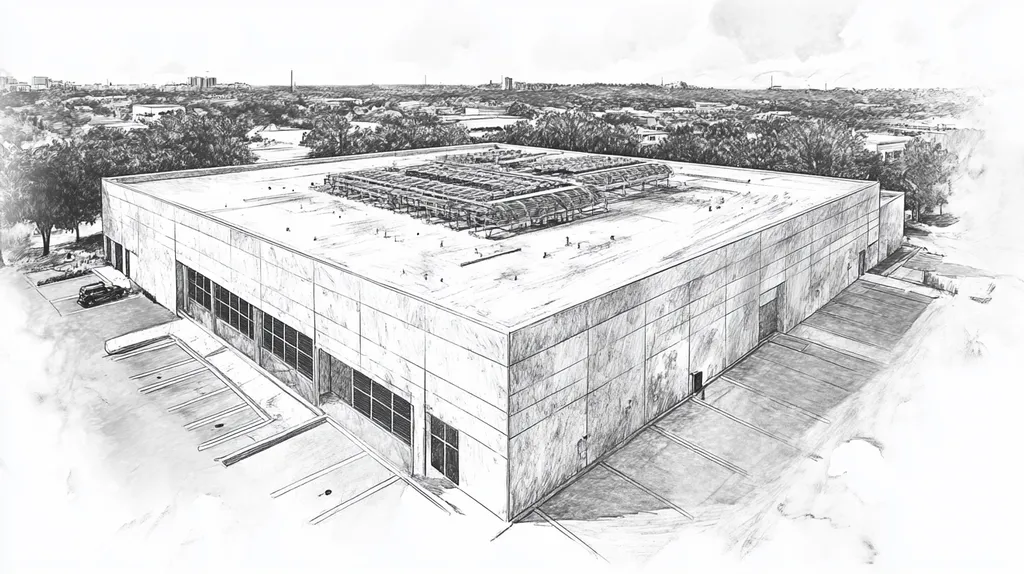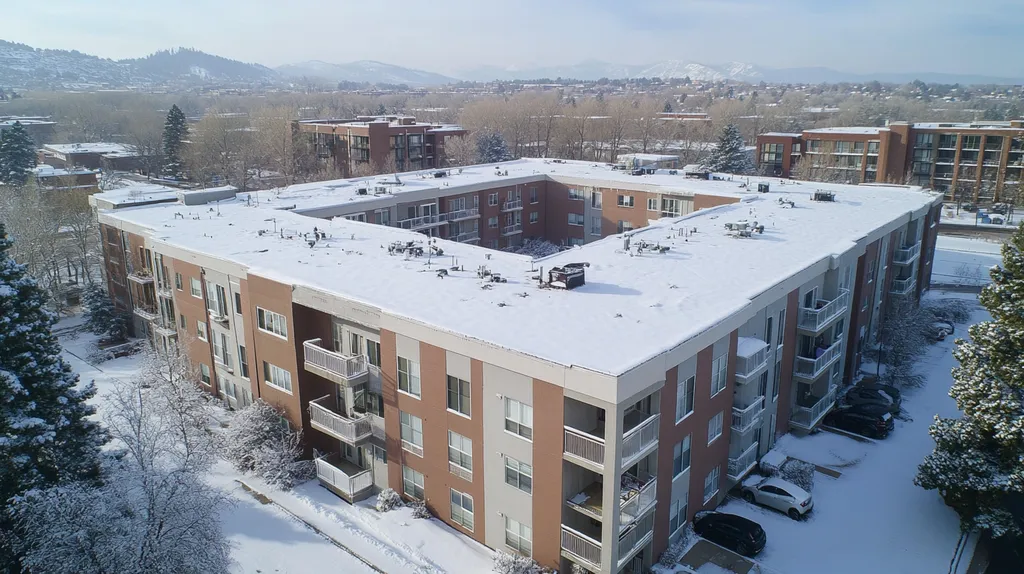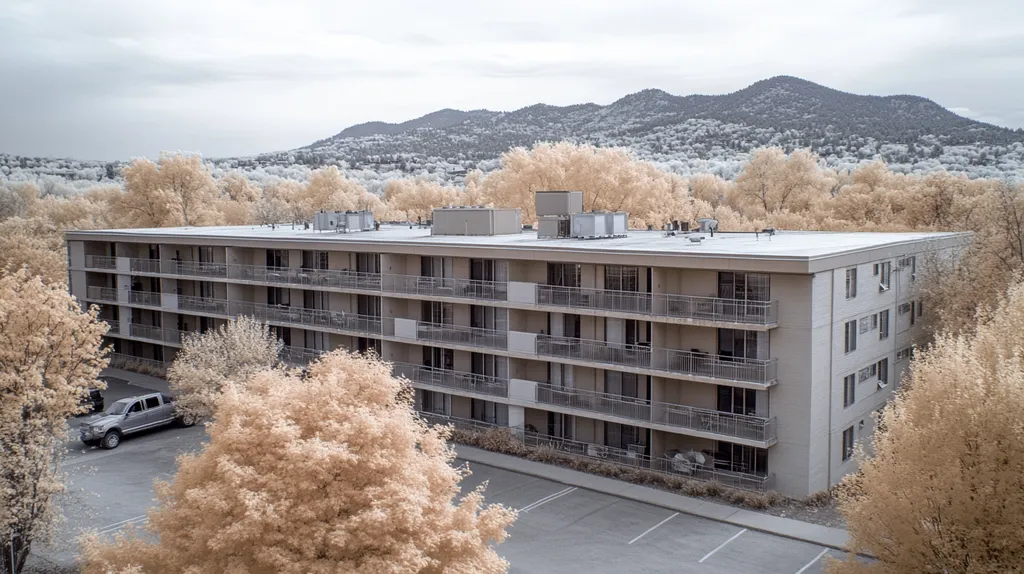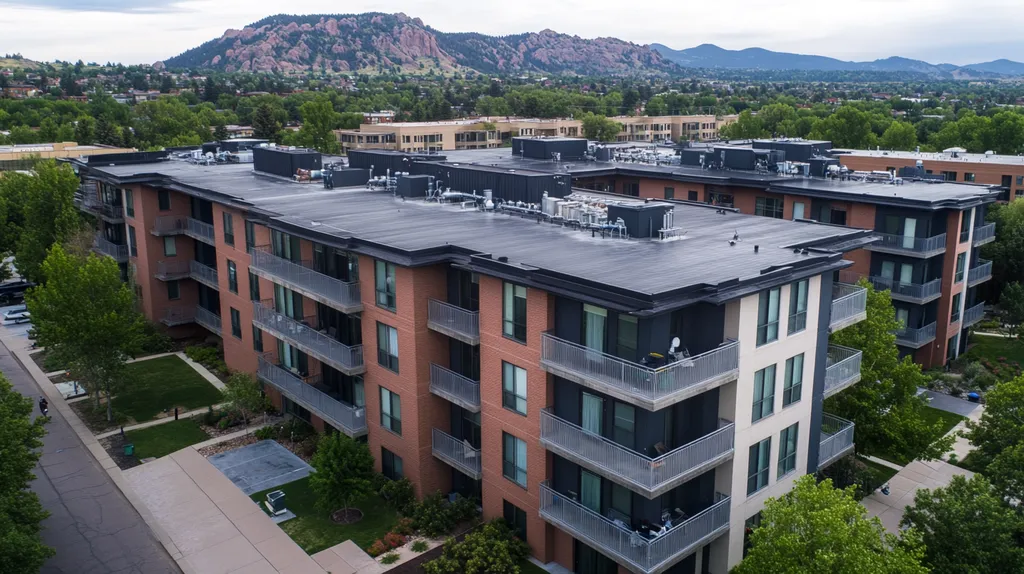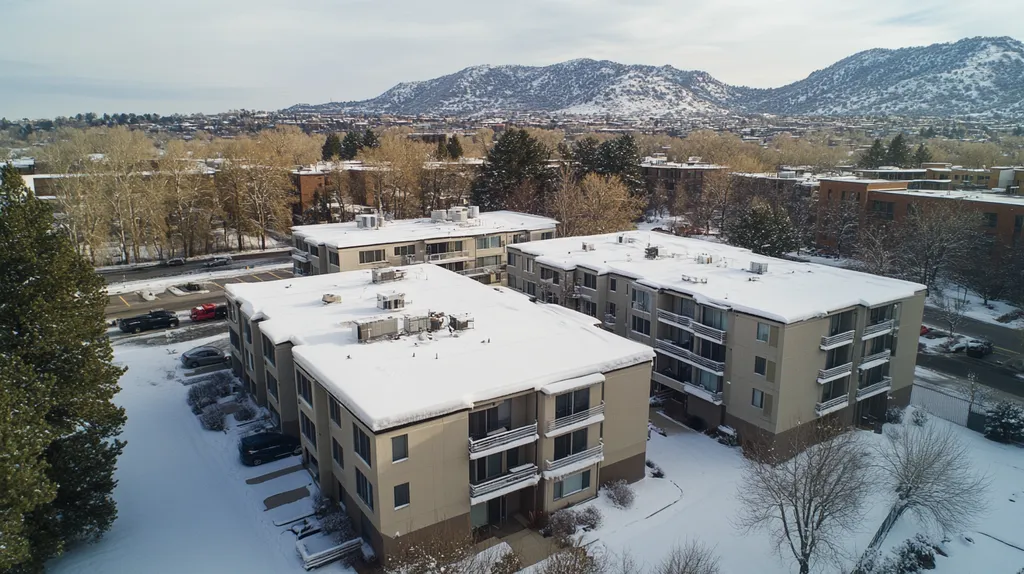Commercial building owners face mounting pressure to reduce energy costs, with lighting systems consuming up to 35% of total electricity usage. Yet poorly integrated roof lighting creates structural vulnerabilities that lead to costly repairs and safety hazards.
Research shows that strategically designed roof lighting systems can slash energy consumption by 30% while extending roof lifespan. However, achieving these benefits requires careful consideration of load capacity, weather resistance, and compliance requirements.
This comprehensive guide provides property managers with an actionable framework for successfully integrating lighting systems into commercial roof design, covering crucial factors from initial planning through long-term maintenance.
SECTION 1: PERFORMANCE FACTORS
Integrating lighting systems into commercial roofs has evolved from a futuristic concept to a critical necessity. Current research indicates that businesses can achieve energy savings of up to 30% by adopting efficient lighting solutions seamlessly blended into their roofing structures. Neglecting to assess crucial factors, including roof load capacity and fixture durability, could lead to significant financial losses and safety risks. Therefore, property owners and facility managers must understand these key performance factors to optimize building efficiency through strategic roof design.
Evaluating Roof Load Capacity for Lighting Integration
Prior to adding lighting systems on commercial roofs, it is essential to evaluate the roof’s load capacity. Each lighting fixture contributes weight that needs to be factored into the initial design to prevent structural complications. A thorough assessment can avert roof collapse, ensuring both the roof and fixtures remain intact for years to come.
Engaging qualified engineers for load capacity assessments is highly recommended. These professionals will identify current structural limitations and suggest necessary reinforcements. For example, adopting heavy LED fixtures may require additional support beams, particularly on flat roofs.
Familiarity with local building codes is also crucial, as these regulations specify the maximum weight roofs can support. Non-compliance can result in hefty fines and legal issues, making adherence to these guidelines non-negotiable.
Key Action Items
Assessing Thermal and Weather Resistance of Fixtures
The choice of lighting fixtures should emphasize thermal and weather resistance to ensure long-term performance. Commercial roofs endure harsh environmental conditions that can adversely affect subpar fixtures. Investing in weather-proof and thermally rated products safeguards against early failures.
Fixtures must be capable of withstanding high temperatures and humidity, particularly in regions subject to these extremes. Selecting products with an IP (Ingress Protection) rating guarantees resistance to dust and moisture, enhancing their lifespan. By choosing durable materials, facility managers can significantly reduce maintenance costs and operational downtimes.
Additionally, energy-efficient LED fixtures often exhibit superior thermal performance compared to traditional options. When integrated into a well-constructed roof system, they deliver effective lighting while conserving energy, aligning with sustainability initiatives.
Key Action Items
Optimizing Natural Light Interaction with Roof Design
Incorporating natural light into commercial roof designs greatly enhances energy efficiency and creates better indoor environments. Solutions like skylights and light tubes enable daylighting, reducing the dependence on artificial lighting and leading to considerable energy savings.
Leveraging natural light can also enhance employee productivity and satisfaction. Research shows that workplaces abundant in daylight can boost productivity by more than 10%. Thoughtful placement of skylights illuminates workspaces and helps lower heating and cooling costs.
Moreover, considering the building’s orientation is vital when designing for natural light. A southern exposure can maximize sunlight during winter months, while an eastern orientation optimizes morning light, minimizing heating needs during colder seasons.
Key Action Items
SECTION 2: FINANCIAL CONSIDERATIONS
The financial implications of integrating lighting systems into commercial roofing designs are significant and can’t be ignored. As energy costs continue to climb, property owners must rethink their strategies to include lighting solutions that boost functionality while driving savings. Recent studies indicate that buildings with integrated lighting systems can lower energy costs by up to 30%. It’s essential to grasp budget planning, energy efficiency, and available incentives to make the best financial decisions.
Budget Planning and Cost-Benefit Analysis of Integrated Lighting
Effective budget planning is key when considering integrated lighting for commercial roofs. While the upfront investment may feel intimidating, the long-term savings often outweigh these initial costs. A thorough cost-benefit analysis should encompass installation costs, ongoing maintenance, and energy savings projected over time.
It’s vital to calculate potential payback periods. For instance, systems using LED technology can typically provide a return on investment within three to five years. Knowing these figures empowers property owners to justify expenses to stakeholders.
Additionally, account for any structural reinforcements required for new lighting systems. By evaluating these potential costs early on, property owners can avoid budget overruns and ensure sound financial planning.
Key Action Items
Energy Efficiency and Utility Cost Reduction Strategies
Integrating lighting systems into roofing design not only boosts energy efficiency but also dramatically reduces utility costs. For example, carefully positioned LED fixtures can deliver higher light output while consuming less energy compared to traditional bulbs, leading to lower monthly energy bills.
Additionally, using daylight harvesting techniques can greatly enhance natural light utilization, which further cuts energy consumption. This method strategically positions windows and skylights to maximize sunlight, reducing reliance on artificial lighting during daytime.
Post-installation, tracking energy consumption becomes essential. Building owners can use smart energy management systems to analyze usage patterns and discover further savings opportunities. This proactive approach fosters continuous improvement in efficiency.
Implementing these energy efficiency strategies decreases operating costs and increases the building’s market value and appeal.
Key Action Items
Incentives, Rebates, and Long-Term Financial Impact
Understanding the incentives for integrating lighting systems is essential for effective financial planning. Many utility companies offer rebates for energy-efficient upgrades, easing the burden of initial investments. Government programs frequently provide grants or tax credits to promote sustainable building practices.
Researching local and federal incentives can significantly diminish out-of-pocket costs for property owners. For example, some businesses may be eligible for a 30% tax credit on energy-efficient improvements, which can substantially lower overall expenses.
While immediate savings are compelling, it’s crucial not to overlook the long-term financial benefits. Buildings with integrated lighting often command higher rental rates and attract environmentally-conscious tenants, boosting overall property values.
By leveraging available financial resources, property owners can make informed decisions, ensuring a sustainable and profitable future for their properties.
Key Action Items
SECTION 3: COMPLIANCE REQUIREMENTS
Integrating lighting systems into commercial roofing design is not just an upgrade; it’s a necessity that comes with regulatory responsibilities. Compliance with local building and electrical codes is essential to avoid hefty fines and ensure the safety of all occupants. Meeting energy efficiency standards is equally important in a competitive market increasingly focused on sustainability. In this section, we will examine the critical compliance areas affecting roofing projects.
Adhering to Local Building and Electrical Codes
Local building and electrical codes dictate everything, from structural integrity to the safe installation of lighting systems. These regulations can differ widely depending on the location, so understanding your jurisdiction’s specific requirements is vital. Facilities that fail to comply may face severe penalties, potentially even mandatory removal of non-compliant installations.
For instance, certain regions necessitate specific wiring types and conduits for outdoor lighting to withstand harsh environmental conditions. Compliance contributes to safety and legal protection for property owners. Regular inspections by local authorities can uncover potential violations before they escalate into costly repairs.
Hiring qualified roofing and electrical contractors who specialize in local codes can streamline this compliance process. They can offer valuable insights regarding required permits and code updates, simplifying project timelines and minimizing disruptions.
Key Action Items
Meeting Energy and Environmental Certification Standards
Modern commercial properties are increasingly evaluated based on their energy efficiency and environmental impact. Many owners strive for certifications such as LEED, which require compliance with strict energy standards. Integrating compatible lighting systems into roofing design is vital for obtaining these certifications.
Energy-efficient lighting solutions can also qualify for tax incentives and rebates, helping to mitigate installation expenses. Utilizing LED technologies, known for their low energy consumption, can support compliance and improve overall building performance.
Incorporating renewable energy sources like solar panels with your lighting systems is another way to achieve compliance. This strategy not only satisfies certification requirements but also provides long-term energy savings, making properties more desirable to potential tenants.
Key Action Items
Emergency and Safety Lighting Regulation Compliance
Compliance with emergency and safety lighting regulations is crucial for protecting occupants and property. These regulations dictate the type and placement of emergency lighting systems, ensuring they are both functional and accessible during emergencies.
The National Fire Protection Association (NFPA) mandates that emergency lighting systems provide adequate visibility along egress paths, allowing safe evacuations during crises. Non-compliance can lead to severe injuries and potential lawsuits.
Regular testing and maintenance of emergency lighting systems are also mandated. Property owners must schedule routine inspections to confirm that these systems operate correctly and fulfill safety requirements. Failure to do so can result in malfunctions during critical times, jeopardizing safety.
Key Action Items
SECTION 4: RISK MANAGEMENT
Integrating lighting systems into commercial roofing comes with significant challenges that demand a thoughtful approach to risk management. Property owners must prioritize structural integrity and safety. For instance, improper lighting installation can impose additional weight on roofs, heightening the risk of structural failure. Identifying and addressing these risks upfront is essential to avoiding costly repairs and ensuring the building performs optimally over the long term.
Identifying Structural Risks from Lighting Installation
When incorporating lighting systems onto roofs, it is crucial to thoroughly assess the structural risks involved. Roofs are engineered to handle specific loads, factoring in all roofing materials and environmental influences. Adding new lighting requires careful analysis of weight distribution and load-bearing capabilities.
While LED fixtures are generally lightweight, the cumulative weight of mounting hardware and wiring can be substantial. By evaluating these factors, property owners can prevent unforeseen stress on roofing structures, which might otherwise lead to deformation or leaks.
Engaging roofing professionals during the planning stage is essential. These experts can conduct load assessments and recommend necessary structural reinforcements. Regular inspections after installation are also vital for monitoring any signs of structural distress, ensuring long-term investment security.
Key Action Items
Mitigating Electrical and Fire Hazards
Electrical safety is a critical issue when integrating lighting systems into roofs. Poorly designed electrical configurations may lead to overheating, short circuits, and even fires. Using inadequate wiring poses long-term risks that can jeopardize safety.
To minimize hazards, adhering to electrical codes and safety standards is imperative. Utilizing certified components and ensuring reliable connections throughout the system will enhance safety. Collaboration with licensed electricians experienced in roof lighting installations is highly recommended.
Incorporating surge protection devices can further shield lighting systems from voltage spikes that can damage components and create fire hazards. Regular maintenance checks allow for early identification of wear, such as frayed wires, ensuring compliance with safety regulations and extending the lifespan of the system.
Key Action Items
Planning for Maintenance and System Longevity Risks
Once a lighting system is integrated into a roofing design, proactive planning for ongoing maintenance is essential. Neglecting maintenance can lead to failures requiring expensive repairs. Regular upkeep ensures that all components operate correctly and safely.
Establishing a maintenance schedule that includes routine inspections, cleaning, and timely repairs is crucial for longevity. Ensuring roofs are easily accessible for maintenance teams reduces accidental risks and enhances inspection efficiency.
Additionally, staying informed about advancements in lighting technology may warrant retrofitting older systems with more efficient options that lower operational costs. Building a culture of regular system review can significantly impact the durability and functionality of roofing investments.
Key Action Items
SECTION 5: OPERATIONAL PROCEDURES
Integrating lighting systems into roof design is critical for operational efficiency and energy savings. With lighting contributing significantly to energy expenses, property owners must focus on effective operational procedures for seamless implementation. By establishing a coordinated plan for installation, routine inspections, and maintenance, stakeholders can enhance the overall performance of both roofing and lighting systems.
Installation Sequencing and Coordination with Roofing
Efficiency is crucial in commercial roofing projects, where poor coordination can lead to delays and increased costs. Ensuring that the structural supports for lighting are installed simultaneously with the roof deck can prevent significant issues down the line.
A detailed project timeline with specific deadlines for various tasks can help align all contractors. Including checkpoints for roofing applications and lighting placements keeps everyone accountable and informed during installation.
Strong communication between roofing and electrical teams is essential. Appointing a lead contractor to oversee discussions ensures timely updates on any project changes.
Additionally, consider opting for prefabricated lighting systems. These efficient units can expedite the process, making integration into the roofing structure quicker and more straightforward.
Key Action Items
Routine Inspection and Performance Verification Methods
Routine inspections are essential for keeping both roofing and lighting systems operational. Implementing a standardized inspection checklist that examines the integrity of the roof and the performance of lighting can identify potential issues early on. For instance, checking for water seepage around fixtures can avert electrical hazards.
Utilizing modern technology enhances the inspection process. Drones and thermal imaging can provide in-depth assessments of roofing conditions that traditional methods may overlook, helping to identify heat loss or moisture issues that could affect lighting.
Regular performance checks of lighting systems are equally important. Measuring lumen output and energy consumption ensures these systems are functioning at optimal levels.
Documenting findings during inspections not only informs future maintenance schedules but also builds a historical performance record for both roofing and lighting systems.
Key Action Items
Maintenance Scheduling and Troubleshooting Protocols
A comprehensive maintenance schedule is vital for preserving the functionality of integrated lighting and roofing systems. Without routine upkeep, components can deteriorate, leading to expensive repairs. Establish a proactive maintenance plan that includes regular cleanings to avoid debris build-up impacting lighting efficiency.
In addition, developing a troubleshooting guide for common problems like flickering lights or leaks can help facility managers act quickly to resolve issues, minimizing downtime.
It’s crucial to train staff on maintenance protocols. Knowledge of the interdependencies between roofing and lighting systems will enable them to identify potential problems before they escalate.
Partnering with a service provider familiar with both roofing and lighting systems can enhance maintenance efforts, ensuring expert advice is available for any issues that arise.
Key Action Items
SECTION 5: OPERATIONAL PROCEDURES
Integrating lighting systems into roof design is not just an innovation; it’s a necessity. With up to 30% of energy costs stemming from poor lighting choices, property owners must prioritize effective operational procedures for successful implementation. Creating a well-coordinated plan for installation, regular inspections, and maintenance is essential for maximizing the benefits of this integration. This section outlines these crucial operational steps to ensure the effectiveness and longevity of both roofing and lighting systems.
Installation Sequencing and Coordination with Roofing
Time is money, especially for commercial roofing projects. Poor coordination can lead to costly delays and rework. For effective integration, it is vital to ensure that structural supports for lighting are installed alongside the roof deck to prevent future complications.
A detailed project timeline with deadlines for each step can help align all contractors involved. Specific checkpoints for roofing applications and lighting placements ensure accountability and communication throughout the installation process.
Regular communication among roofing and electrical teams is integral for success. Appointing a lead contractor streamlines discussions and updates on any project changes.
Additionally, consider opting for prefabricated lighting systems. These units can expedite the installation process, allowing for quicker integration into the overall roofing structure.
Key Action Items
Routine Inspection and Performance Verification Methods
Routine inspections are vital for the successful operation of integrated systems. Implementing a standard inspection checklist focusing on both roofing integrity and lighting functionality can help identify issues early. For example, checking for water seepage around light fixtures during rain can prevent potential electrical hazards.
Utilize modern technology to enhance inspections. Drones and thermal imaging can provide comprehensive assessments of roofing conditions that traditional methods might overlook, helping to pinpoint heat loss or moisture buildup that can affect lighting performance.
Performance verification should regularly measure lumen output and energy consumption to ensure lighting systems operate optimally.
Documenting all findings during inspections is essential. This practice assists in maintaining a current maintenance schedule and builds a historical record of both the roof and fixtures’ performance over time.
Key Action Items
Maintenance Scheduling and Troubleshooting Protocols
A comprehensive maintenance schedule is vital for preserving the functionality of integrated lighting and roofing systems. Without routine upkeep, components can deteriorate, leading to expensive repairs. Establish a proactive maintenance plan that includes regular cleanings to avoid debris build-up impacting lighting efficiency.
Develop a troubleshooting protocol for common issues, such as flickering lights or leaks. Quick access to a clear guide can enable facility managers to resolve problems swiftly, minimizing downtime.
Training staff on maintenance procedures is crucial. They should understand the specific interdependencies between roofing and lighting systems to recognize potential issues before they escalate.
Partnering with a service provider familiar with both roofing and lighting can enhance maintenance efforts, ensuring expert advice is readily available for any issues that arise.
Key Action Items
The Bottom Line
The integration of lighting systems into commercial roofing represents a critical inflection point for the industry, with studies showing potential energy savings of 30-40% for buildings that implement these solutions effectively.
However, nearly 65% of commercial properties still rely on outdated lighting configurations that compromise structural integrity and inflate operating costs.
As energy prices continue climbing and environmental regulations tighten, property owners who delay modernizing their roof lighting systems risk significant financial exposure and compliance violations.
Success requires careful attention to structural capacity, weather resistance, and long-term maintenance – supported by thorough documentation and regular professional inspections.
The time for strategic lighting integration is now, as waiting only increases vulnerability to rising costs and evolving regulations.
FREQUENTLY ASKED QUESTIONS
Q. What factors should I consider for a commercial roof’s load capacity?
A. Evaluating roof load capacity involves assessing the weight contributions from lighting fixtures and their hardware. Engaging engineers for proper load assessments ensures structural safety, preventing costly damage and maintaining compliance with local building codes.
Q. How can a commercial roof benefit from energy-efficient lighting?
A. Integrating energy-efficient lighting on commercial roofs can lower utility costs significantly, sometimes by up to 30%. This not only improves overall energy efficiency but also enhances the building’s market value while promoting sustainable operational practices.
Q. What codes must commercial roofs comply with after installing lighting?
A. Compliance involves meeting local building and electrical codes, as well as ensuring adherence to energy-efficient standards. Failure to meet these can lead to fines or the need for costly system modifications.
Q. How can I ensure my commercial roof’s lighting is safe?
A. To ensure safety, hire qualified electricians to install the lighting and regularly maintain electrical systems. Additionally, following established electrical codes and conducting inspections can help identify and mitigate hazards before they escalate.
Q. What should I include in a commercial roof’s maintenance plan?
A. A maintenance plan should include routine inspections, cleaning tasks, and documentation for both roofing and lighting systems. Regularly scheduled checks can help identify issues early and extend the lifespan of all integrated components.
Q. What role does natural light play in commercial roofing design?
A. Incorporating elements like skylights in commercial roofs enhances natural light, reducing reliance on artificial lighting. This strategy not only saves energy but also fosters a healthier and more productive workspace for building occupants.
Q. How can I assess my commercial roof for potential lighting expansion?
A. To assess potential for expansion, analyze the current load capacity, structural support, and future energy needs. Creating a flexible design and consulting with roofing professionals can facilitate smooth integration of additional lighting in the future.

